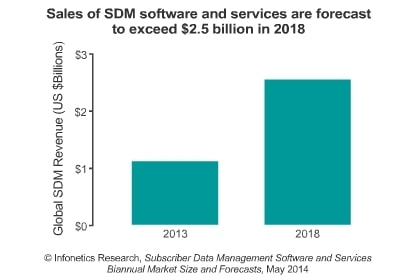Subscribers are already seeing their IPTV, cellular connections, fixed broadband and telephone services being billed in a single end-of-month statement as an increasing number of quadplay service providers offer the entire suite to their subscribers. The consolidation of subscribers information in the network has enabled not only converged billing, but also enables provisioning of new services, attendance to customer enquiries and cross selling that is based on a complete view of all the subscriber's subscriptions and packages, activity and usage, payments, updates and personal information.
With the increase in packages, bundles, offers and with increased flexibility accorded to subscribers, the market for consolidated Subscriber Data Management (SDM) systems for networks continues to grow, reaching $1.1 billion in 2013 and expected to touch $2.5 billion by 2018. These figures, reported by Infonetics Research, a market research firm, in its recent Subscriber Data Management Software and Services report indicate that more and more Operators are deploying these newer systems. According to Infonetics, operators are continuing to modernize their networks, replacing the legacy databases such as HLR and AAA with SDM software to ensure a consistent representation of subscriber information across various data sources. Infonetics also higlighted that the Voice Over LTE (VoLTE) is one of the key drivers to the deployment of the SDM, as it enables Operators to manage data across multiple network domains. The SDM also helps Operators to achieve leaner operations and lower their Opex.
“Now that the concept of a standalone subscriber data repository has gained acceptance, the next big thing in subscriber data management will be monetizing that unified data. Many operators are already leveraging consolidated subscriber data for internal use, and some are exploring options for brokering that data externally."
“Concerns about exposing subscriber data, even data that’s been aggregated and made anonymous, still exist, but there’s growing interest among operators in becoming identity providers, offering authentication and authorization services to third parties like content providers, retailers, and financial institutions.”
- Shira Levine, Directing Analyst for Service Enablement and Subscriber Intelligent, Infonetics Research





















